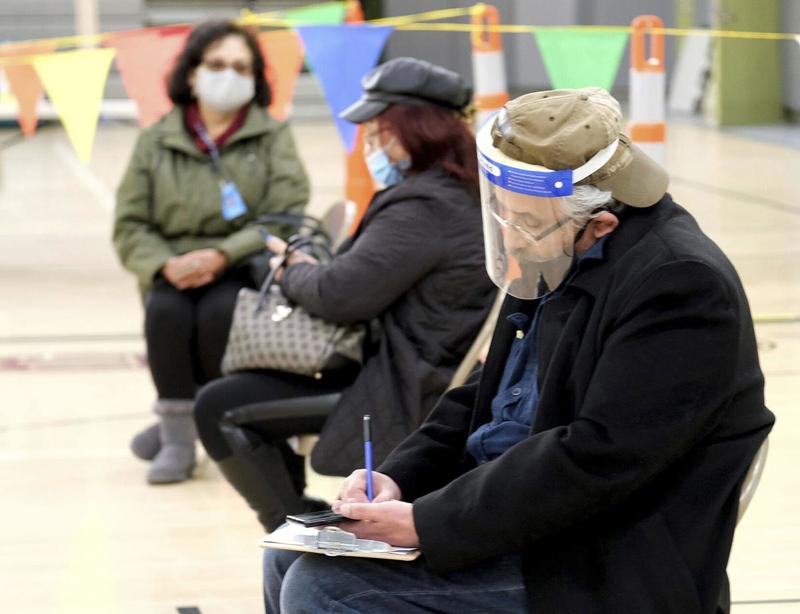 Raymundo Armagnac, a teacher, fills out forms before getting his first dose of the Moderna vaccine on Feb 17 in Los Angeles. (DEAN MUSGROVE / AP)
Raymundo Armagnac, a teacher, fills out forms before getting his first dose of the Moderna vaccine on Feb 17 in Los Angeles. (DEAN MUSGROVE / AP)
A pickup in COVID-19 vaccinations in the United States has exposed a widening gulf in some parts of the country where members of minority groups are getting jabbed at lower rates than white people.
A distrust of the vaccines is seen as a factor in this trend, prompting outreach efforts from public health officials. Blacks, Hispanics and Asian Americans account for the main groups identified as falling behind.
Blacks are receiving 3.5 percent of all administered shots in Los Angeles County, highlighting what officials called "a glaring inadequacy in the vaccine rollout to date", according to a Feb 8 report by the Los Angeles County Department of Public Health.
According to 2019 US Census estimates, the black population of the county was estimated at 8.1 percent of the total.
In comparison, 25 percent of the doses were administered to white residents, a further 25 percent were given to Latinos, 18 percent to residents of Asian backgrounds, and 17 percent to those who identify as multiracial.
"We're alarmed by the disproportionality we're seeing in who has received the vaccine," said Los Angeles County Public Health Director Barbara Ferrer, who added that the government needs to make it easier for residents and workers to be vaccinated in their communities by providers they trust.
The pandemic has taken a disproportionate toll on low-income earners and people of color, who are more likely to work in essential jobs and suffer from underlying health conditions.
Los Angeles County, a region with wide income disparities, has a large service sector that is predominantly made up of Latino and African-American workers.
ALSO READ: COVID-19 vaccine distribution needs to be fair and transparent
The pattern of inequality that revealed itself in both the cases of COVID and the availability of testing are being demonstrated in the vaccine rollout.
Manuel Pastor, sociology professor and director of the University of Southern California's Equity Research Institute
Manuel Pastor, sociology professor and director of the University of Southern California's Equity Research Institute, said the new report "reveals what we already knew: that our public health infrastructure is weakest in communities that are low-income and predominantly people of color".
He wrote in an email to China Daily: "The pattern of inequality that revealed itself in both the cases of COVID and the availability of testing are being demonstrated in the vaccine rollout."
Further complicating the matter is a hesitancy among minority groups to get immunized, a phenomenon cited by various studies that is prompting officials to increase their outreach.
People of color, especially black Americans, are more hesitant to get the vaccine due to a long history of medical abuse directed against them, Pastor said.
"The antidote to COVID is the vaccine, and the antidote to vaccine hesitancy is combining trusted messengers with a mobile rollout that gets to communities where they live," he said. "The current mega-centers are important so we can do scale, but they're much easier for people with cars, computers and class privileges."
Unwillingness
A December survey from the Kaiser Family Foundation found that around 35 percent of black adults said they definitely or probably wouldn't get vaccinated.
About 47 percent of the group cited a lack of trust in the vaccines in general as a major reason. Around 50 percent said they are worried that they may get COVID-19 from the vaccine, suggesting that messages addressing particular types of misinformation may be especially important for increasing vaccine confidence, researchers said.
"This pandemic has really exposed the failures of our healthcare system," said Representative Raul Ruiz, a Democrat from California who represents a district with many Latino farmworkers with limited healthcare.
"We cannot rely on this healthcare system to address equity. ... We are only going to continue to fail. And we see that now with the vaccine distribution."
In New York City, Mayor Bill de Blasio recently shared demographic data that showed the number of white New Yorkers that had received their first dose is more than double that of any minority group. Most of the COVID-19 vaccines require two shots.
According to the city's tally, 48 percent of white people have received their first shots. In contrast, just 15 percent of Asians and Hispanics had done so, and only 11 percent of African Americans.
READ MORE: When will life return to normal? In 7 years at today’s vaccination rate
Contact the writer at teresaliu@chinadailyusa.com


